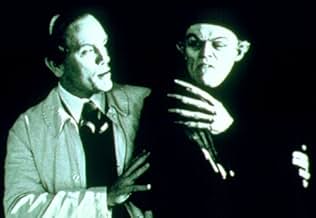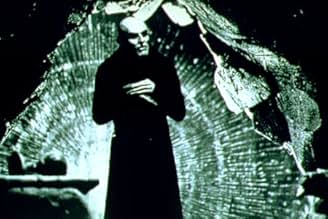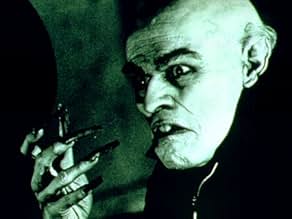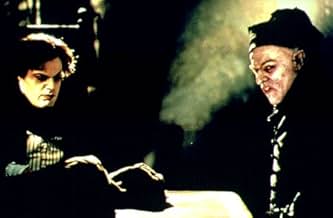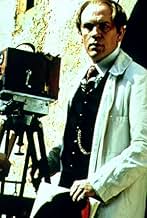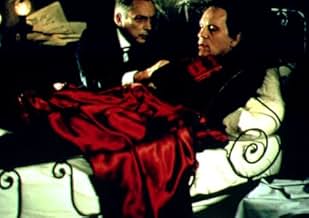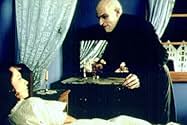Em 1922, o director alemão F. W. Murnau decide fazer o filme "Nosferatu" e contrata um actor desconhecido para o papel principal, mas surgem algumas perturbações durante as filmagens que sug... Ler tudoEm 1922, o director alemão F. W. Murnau decide fazer o filme "Nosferatu" e contrata um actor desconhecido para o papel principal, mas surgem algumas perturbações durante as filmagens que sugerem que há um vampiro nas imediações.Em 1922, o director alemão F. W. Murnau decide fazer o filme "Nosferatu" e contrata um actor desconhecido para o papel principal, mas surgem algumas perturbações durante as filmagens que sugerem que há um vampiro nas imediações.
- Indicado a 2 Oscars
- 16 vitórias e 30 indicações no total
- Henrik Galeen
- (as John Aden Gillet)
- Paul - Camera Assistant
- (as Nicholas Elliot)
- Innkeeper
- (as Milos Hlavak)
- Drunken Woman
- (as Sacha Ley)
- Old Woman
- (as Marie Paule Van Roesgen)
Avaliações em destaque
Having assembled his crew, Murnau (John Malkovich) travels to a small town in Czechoslovakia, where he intends to recreate before his camera the story of Bram Stoker's "Dracula". Set on creating the most realistic vampire film, Murnau secretly recruits a real vampire (Willem Dafoe), promising to recompense the creature with leading lady Greta (Catherine McCormack). Murnau cautiously introduces the vampire to his producer Albin Grau (Udo Kier) and scriptwriter Henrick Galeen (John Gillet) as "Max Schreck", a truly professional "method actor" trained by Stanislavsky. Schreck performs his scenes suspiciously well, only appearing on the set at night and in character, keeping his end of the bargain with the director. Soon, however, his blood thirst takes over and he fearlessly threatens to eliminate, one by one, Murnau's most dispensable crew members.
Shadow of the Vampire stems from the premise that its protagonist, the fictional Murnau (Malkovich), must hire a real vampire in order to ensure a truly authentic representation of the vampire character, "Count Orlock", for his film Nosferatu. The viewer who seeks a more accurate portrayal of the making of the real Nosferatu may find this premise strained and far-fetched, and may even consider the film's ensuing humor a bit aimless. However, Shadow of the Vampire integrates the humorous premise to its metaphorical exploration of the artistic process and of the inevitable struggle between the star, the director and the crew. (In one scene, Schreck tries to secure his interests --a new victim-- by negotiating with Murnau. He reflects: "I don't think we need the writer any longer.") Aside from the film's complex treatment of the film within the film and of the character within the character (where Shadow of the Vampire re-presents Nosferatu, and Shadow's cast plays Nosferatu's cast), the film's most enjoyable aspect is its careful reconstruction of specific Nosferatu scenes. When demonstrating how Murnau shoots these well-known scenes, Shadow's own shots shift between black & white and color; from a full-frame to one enclosed by an iris. Shadow's recreation of the classic scenes are often accompanied by Murnau's off-screen voice-over instructions to the actors, who in turn stop in mid-shot, enter, or exit the frame. These choices offer a fantastic depiction of silent film technique, and they as well add new life and a sort of magical dimension to the original Nosferatu scenes. Undoubtedly, Shadow of the Vampire may be most fully appreciated by the viewer that has already developed a sensitive appreciation for Nosferatu's unforgettable images. Still, Shadow of the Vampire may be enjoyed as well by those fascinated by filmmaking or --as Shadow's Murnau put it-- by "the science of the creation of memory."
This is an inventive film that looks at how far art will go to create. The director Murnau seems as driven by the creative process as Shreck is by his lust for blood. This comparison is carried through the whole film until the inevitable showdown between the two drives. The setup itself is fascinating but the comparison between the two men makes it even better.
The film is well shot and uses the different cameras well. It looks really good and mixes bright shots with shadowy darkness really well. It also benefits from a good cast. Malkovich is excellent as the driven director who easily becomes a monster himself but Dafoe is even better. Despite being almost unrecognisable under the make up, Dafoe manages to bring humanity to his monster he also brings some humour without making his a comedy role. Elwes is underused, but Izzard is great as a bad 1920's actor!
Overall this may not inspire interest in everyone but it has a great cast and a good central story. The comparisons drawn between Murnau and Shreck only improve what is already a very enjoyable film.
This is a beautiful film with sumptuous cinematography, wardrobe, and sets. The performances range from static to sensational with an unrecognizable Willem Dafoe stealing the show. Although, there is a lot left to embrace even when he leaves the frame.
It is an offbeat movie to say the least and will be a tough swallow for some. It does wallow in its own craziness but not to the point of distraction. There are some rough inconsistencies to the story but are swept away in the fun and creepiness of it all.
For those willing to imagine the absurd this is quite a conceit to behold. It is all believable in a world gone mad sort of way and it is presented in such a reverential and dutiful way that it can't help but be admired.
I've never really been a big fan of Nosferatu nor a particular admirer of Willem Dafoe, but this bizarre little movie has made me appreciate both much more. A fictionalised account of the making of F.W. Murnau's 1922 silent horror classic, Shadow of the Vampire toys with the notion that Nosferatu's star Max Schreck (played here by Dafoe) was actually a bona fide member of the undead.
This fanciful idea plays out a little too slowly, perhaps, but offers plenty of opportunity for dark humour, the cast delivering suitably offbeat performances that prove strangely intoxicating, with Dafoe's mesmerising turn as Shreck being the film's strongest suit, the actor's mannerisms and expressions played to perfection.
Casual movie fans who haven't seen Murnau's classic will probably wonder what the hell is going on, so I recommend seeing Nosferatu beforehand, just so that one can fully appreciate the magic of certain scenes and the brilliance of Dafoe's performance.
Você sabia?
- CuriosidadesBased in part upon a legend that Max Schreck was in reality a vampire which is why he played the role of Orlok/Dracula so well. Some variations of the legend suggest that Nosferatu (1922) was the only film Schreck made, though in reality he was already a stage and screen veteran by the time Nosferatu was shot, and would appear in many non-vampiric roles before his death in 1936.
- Erros de gravaçãoThere is a reflection of Count Orlock's head in the mirror moments after a big deal was made about the fact that he cast no reflection in the same mirror (although this is possibly a deliberate nod to Nosferatu (1922) in which a similar error was made).
- Citações
[Asked what he thought of the book, Dracula]
Max Schreck: It made me sad.
Albin: Why sad?
Max Schreck: Because Dracula had no servants.
Albin: I think you missed the point of the book, Count Orlock.
Max Schreck: Dracula hasn't had servants in 400 years and then a man comes to his ancestral home, and he must convince him that he... that he is like the man. He has to feed him, when he himself hasn't eaten food in centuries. Can he even remember how to buy bread? How to select cheese and wine? And then he remembers the rest of it. How to prepare a meal, how to make a bed. He remembers his first glory, his armies, his retainers, and what he is reduced to. The loneliest part of the book comes... when the man accidentally sees Dracula setting his table.
- Cenas durante ou pós-créditosCredits end with the sounds of the camera filming and of the phonograph which set the mood for the actors.
Principais escolhas
- How long is Shadow of the Vampire?Fornecido pela Alexa
Detalhes
- Data de lançamento
- Países de origem
- Idiomas
- Também conhecido como
- La sombra del vampiro
- Locações de filme
- Vianden, Luxemburgo(Castle interior scenes)
- Empresas de produção
- Consulte mais créditos da empresa na IMDbPro
Bilheteria
- Orçamento
- US$ 8.000.000 (estimativa)
- Faturamento bruto nos EUA e Canadá
- US$ 8.293.784
- Fim de semana de estreia nos EUA e Canadá
- US$ 150.171
- 1 de jan. de 2001
- Faturamento bruto mundial
- US$ 11.155.214
- Tempo de duração1 hora 32 minutos
- Cor
- Mixagem de som
- Proporção
- 2.35 : 1
Contribua para esta página





